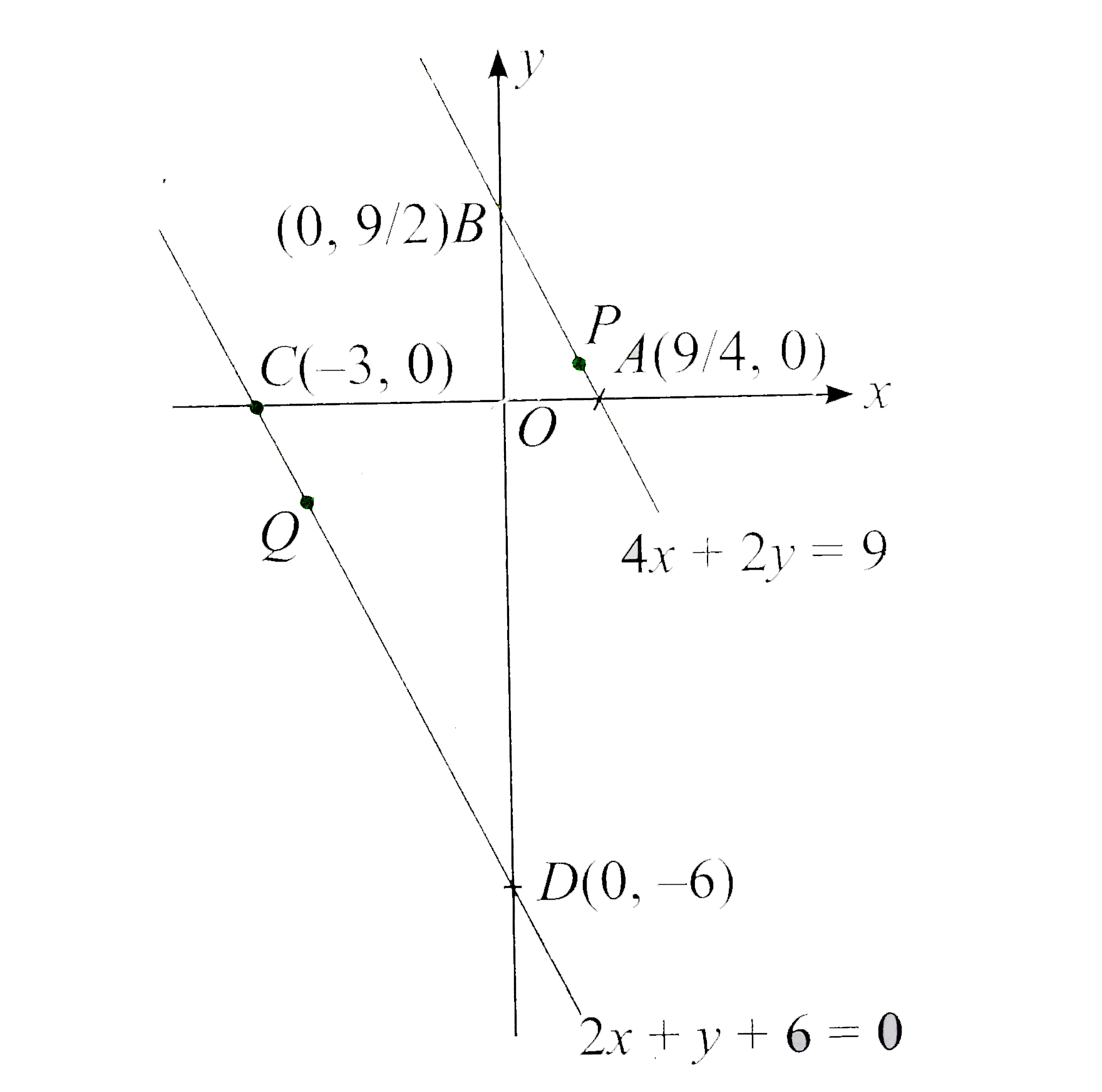A straight line through the origin 'O' meets the parallel lines 4x+2y=9 and 2x+y=−6 at points P and Q respectively. Then the point 'O' divides the segment PQ in the ratio Solution in Tamil
1:2
3:4
2:01
4:3
The correct Answer is:B
Let any line through the origin meets the given lines at P and Q as shown in figure.

Now, from the figure, triangles OAP and OCQ are similar.
Therefore,
OPOQ=OAOC=9/43=34
Topper's Solved these Questions
- STRAIGHT LINESBOOK - CENGAGECHAPTER - STRAIGHT LINESEXERCISE - Exercise (Multiple)
30 Videos
- STRAIGHT LINESBOOK - CENGAGECHAPTER - STRAIGHT LINESEXERCISE - Exercise (Comprehension)
27 Videos
- STRAIGHT LINESBOOK - CENGAGECHAPTER - STRAIGHT LINESEXERCISE - Exercise 2.6
5 Videos
- STRAIGHT LINEBOOK - CENGAGECHAPTER - STRAIGHT LINEEXERCISE - Multiple Correct Answers Type
8 Videos
- THEORY OF EQUATIONSBOOK - CENGAGECHAPTER - THEORY OF EQUATIONSEXERCISE - JEE Advanced Previous Year
9 Videos
Similar Questions
If P is a point (x,y) on the line y=−3x such that P and the point (3, 4) are on the opposite sides of the line 3x−4y=8, then x>815 (b) x>85 y<−85 (d) y<−815
View SolutionLet L be the line belonging to the family of straight lines (a+2b) x+(a-3b)y+a-8b =0, a, b ∈R, which is the farthest from the point (2, 2).
Area enclosed by the line L and the coordinate axes is
View SolutionIf aandb are two arbitrary constants, then prove that the straight line (a−2b)x+(a+3b)y+3a+4b=0 will pass through a fixed point. Find that point.
View SolutionThe point P(α,α+1) will lie inside the triangle whose vertices are A(0,3),B(−2,0) and C(6,1) if
View SolutionQ. Let p and q real number such that p≠0,p2≠q and p2≠−q. if α and β are non-zero complex number satisfying α+β=−p and α3+β3=q, then a quadratic equation having αβ and βα as its roots is
View Solution15 O is the point of intersection of the diagonals AC and BD ofa trapezium ABCD with AB || DC. Through O, a line segment PQ is drawn parallel to AB meeting AD in P and BC in Q. rove that PO=QO ,
View SolutionA straight line through the point A(1,1) meets the parallel lines 4x+2y=9&2x+y+6=0 at points P and Q respectively.Then the point A divides the segment PQ in the ratio:
View SolutionA line with positive direction cosines passes through the point P(2,–1,2) and makes equal angles with the coordinate axes. The line meets the plane 2x+y+z=9 at point Q. The length of the line segment PQ equals
View SolutionA straight line through origin O meets the lines 3y=10−4x and 8x+6y+5=0 at point A and B respectively. Then , O divides the segment AB in the ratio.
View SolutionA line passing through (0,0) and perpendicular to 2x+y+6=0,4x+2y−9=0 then the origin divids the line in the ratio of
View SolutionP(−4,2) और Q(8,3) बिन्दुओ को मिलनेवाली रेखाखण्ड को y -अक्ष जिस अनुपात में बाटती है , वह है :
View SolutionThe tangent at a point P of a curve meets the y-axis at A, and the line parallel to y-axis at A, and the line parallel to y-axis through P meets the x-axis at B. If area of ΔOAB is constant (O being the origin), Then the curve is
View SolutionA straight line through the origin O meets the parallel lines 4x+2y=9and2x+y+6=0 divides the segment ¯¯¯¯¯¯PQ in the ratio-
View Solutionमूलबिन्दु 'O' से जाने वाली एक सरल रेखा, दो समान्तर रेखाओं 4x+2y=9 और 2x+y+6=0 से क्रमशः P बिन्दु Q और पर मिलती है, तो बिन्दु O, रेखाखण्ड PQ को किस अनुपात में विभाजित करेगा ?
View Solution4x+2y=9 এবং 2x+y+6=0 সমান্তরাল সরলরেখা দুটিকে O মূলবিন্দুগামী একটি সরলরেখা যথাক্রমে P ও Q বিন্দুতে ছেদ করে। তাহলে, O বিন্দু ¯¯¯¯¯¯PQ রেখাংশকে যে অনুপাতে বিভক্ত করে তা হবে -
View SolutionThe ratio in which the line segment joining the points P(-3, 10) and Q(6, – 8) is divided by O(-1, 6) is:
View Solution
